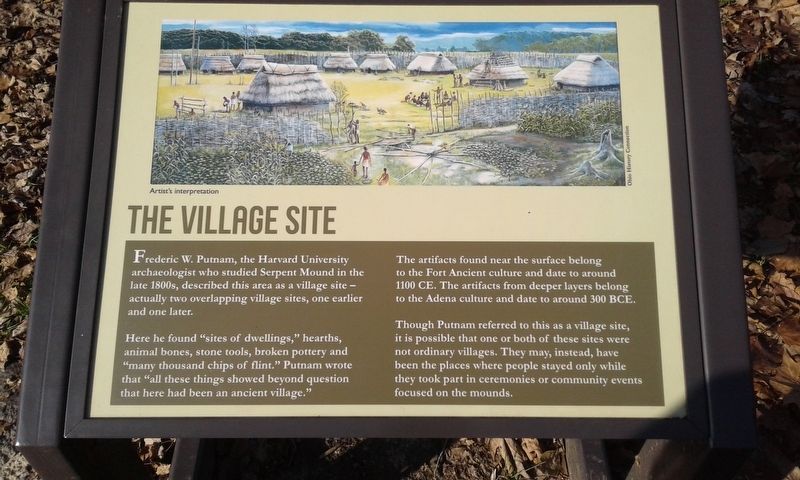Near Peebles in Adams County, Ohio — The American Midwest (Great Lakes)
The Village Site
Frederic W. Putnam, the Harvard University archaeologist who studied Serpent Mound in the late 1800s, described this area as a village site - actually two overlapping village sites, one earlier and one later.
Here he found "sites of dwellings," hearths, animal bones, stone tools, broken pottery and "many thousand chips of flint." Putnam wrote that "all these things showed beyond question that here had been an ancient village."
The artifacts found near the surface belong to the Fort Ancient culture and date to around 1100 CE. The artifacts from deeper layers belong to the Adena culture and date to around 300 BCE.
Though Putnam referred to this as a village site, it is possible that one or both of these sites were not ordinary villages. They may, instead, have been the places where people stayed only while they took part in ceremonies or community events focused on the mounds.
Topics. This historical marker is listed in these topic lists: Anthropology & Archaeology • Native Americans • Notable Places.
Location. 39° 1.45′ N, 83° 25.75′ W. Marker is near Peebles, Ohio, in Adams County. Marker can be reached from Horner Chapel Road (Ohio Route 73) 0.9 miles west of Horner Chapel Road (County Road T-116), on the right when traveling west. Touch for map. Marker is at or near this postal address: 521 Horner Chapel Rd, Peebles OH 45660, United States of America. Touch for directions.
Other nearby markers. At least 8 other markers are within walking distance of this marker. The Serpent In American Indian Traditions (here, next to this marker); What Is An Effigy Mound? (here, next to this marker); The Shawnee And The King Of The Serpents (here, next to this marker); Exploring Serpent Mound (within shouting distance of this marker); Welcome To Serpent Mound (within shouting distance of this marker); Burial Mound (within shouting distance of this marker); Serpent Mound Impact Crater (within shouting distance of this marker); Astronomical Alignments At Serpent Mound (within shouting distance of this marker). Touch for a list and map of all markers in Peebles.
Credits. This page was last revised on January 23, 2023. It was originally submitted on February 4, 2021, by Craig Doda of Napoleon, Ohio. This page has been viewed 256 times since then and 29 times this year. Last updated on January 22, 2023, by Craig Doda of Napoleon, Ohio. Photos: 1, 2. submitted on February 4, 2021, by Craig Doda of Napoleon, Ohio. • Devry Becker Jones was the editor who published this page.

